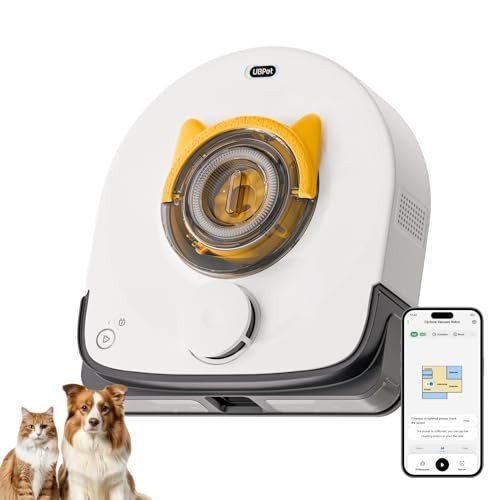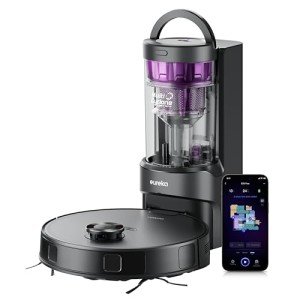What's The Job Market For Smart Robot Professionals?
페이지 정보

본문
 The Benefits of Using a Smart Robot in the Workplace
The Benefits of Using a Smart Robot in the WorkplaceA smart robot vacuum cleaner sale is a type of machine that can perform a variety of tasks, such as monitoring and communicating with humans. This kind of robot is used in a variety of applications, including home automation and healthcare.
A robot that is intelligent can adapt to changing conditions. It uses recognition results to alter its programs and improving performance. It also learns from its experiences and make informed choices.
They are adept at learning and adapting
Smart robots are able to learn and adapt. This is a capability that is becoming more important in a variety of industries. This capability is a result of advancements in artificial-intelligence and machine-learning technologies. Smart robots are able to analyze their surroundings and adjust their behavior in accordance with the environment, allowing them to perform tasks more efficiently and precisely than traditional machines. Smart robots also aid to boost productivity and cut costs.
One of the most expensive robot vacuum important functions of smart robots is predictive maintenance. They can identify issues and fix them before they cause a breakdown, which can save you money. Additionally, they can monitor production processes and adjust settings to improve the product's quality and decrease the number of the risk of defects.
Previously, robots were programmed by human engineers, but new technology is enabling them to learn and adapt to their own. A team of researchers from MIT's Computer Science and Artificial Intelligence Laboratory has created an algorithm that allows intelligent robots to enhance their performance. The system employs a method similar to the way large-scale language models function. The model is based on the idea that robots perform better when their data sets expand and expand. The algorithm allows robots to gain a comprehensive understanding and understanding of their surroundings.
Another way best smart vacuum robots can learn and change is to mimic human behavior. They can take in tactile and visual information to "learn" new techniques. A robot could be shown a photo of a bin full of sporting equipment and then instructed to grab the balls. The robot could make use of an advanced multicamera vision system in order to observe how humans perform the task, and then try to mimic them. This way, it can generate images of what the bin will look like after the balls are taken away and even create a video to show how it would do the job.
This technology can be utilized to teach robots how to communicate with other people. Robots can be taught to understand the alphabet and figures as well as drawings, and communicate with people via voice recognition software. This lets the robots communicate with their owners and complete a wide range of household chores. Robots can also assist to entertain children, take care for the elderly, and provide cognitive behavioral therapy for people suffering from mental illnesses.
They can communicate with humans
Researchers at Brown University have developed a system to allow robots to adjust to their environment and communicate with humans. The system is based on a computer program that can be employed for tasks like picking up objects or navigating through an office building. It also has the capability to learn from past interactions and improve its performance. The system is also able to recognize human actions and predict the robot's next action.
The system uses a combination sensor data and artificial Intelligence in order to detect and interpret human behavior. The robot then alters its actions accordingly. If the robot is just two feet away from a person, it will alter its direction to avoid being too close. If the human is walking in reverse, it will walk slower. In general the robot will attempt to keep a distance of 2 meters from humans. If the robot is directly in front of a human moving, it will move slower. It will also follow a circular route to avoid getting close to the person. This kind of behavior is referred to as socially interactive.
This new technology can revolutionize the future of robots and improve interactions between humans and robots. It can eliminate the requirement for manual control and assist in solving difficult issues. It is also possible to develop an automated robot that can aid in daily tasks. Additionally, it can assist people with disabilities overcome their limitations and live a more active lifestyle.
The majority of robots today are not able to think. The majority of research focuses on bringing human-like intelligence in machines that are able to effectively interact with their environment and complete tasks. This is a difficult goal to accomplish due to the difficulty in modeling the mental state of a person and their behaviour. HRI is studied in many different disciplines, which can cause a dispersed view.
Researchers from the Swiss research institute ETH Zurich in collaboration with the University of Tokyo have found that robots can comprehend language and express their own thoughts. They devised a method to divide and break down instructions into simple commands that robots can follow. The team is hoping to apply this technology to real-world situations outside the lab.
They can perform repetitive tasks
Robots are employed by a wide range of industries to complete tasks such as assembly, food processing and warehouse work. They can do repetitive tasks much faster than humans. They also help reduce human error and boost productivity. These advantages make robots a preferred choice for companies. Robots are a great tool to use in the workplace, but there are risks. Some of these dangers can be easily reduced by educating employees about proper use of robots. For instance when a robot is programmed to move at a speed of 2 to 3 mph, but employees push it to speeds of 4 or 5 mph, they may incur injuries.
Smart robots are already used in many fields. However, new developments will allow them to perform more complex tasks. Some robots, for example are now able to read Braille. They also can communicate with other robots and humans via visual language. Engineers are in the process of incorporating AI processes into their robots in order to increase their capacity to learn and adapt. One such robot is PALM-E that has an automated language system as well as an application that search for data.
These intelligent robots are fitted with sensors and actuators controlled by a central processor. The sensors let the robot detect its surroundings and respond accordingly. Actuators, such as the arms and legs, can be fitted with grippers or claws to manipulate objects. They can also be fitted with distance sensors, locators and servo drives. They come with a control system as well as a power source.
Smart robots are able to handle products in a myriad of configurations for third-party logistics (3PL) and direct-to-customer businesses. This lowers the risk of labor and saves companies money. These machines can handle delicate parts such as electronics, medical components and food. They also can adapt to changing requirements for product mix by altering their configurations. This is a huge improvement over the current technology that requires most expensive robot vacuum hardware as well as complicated software.
In the next phase, Smart robot we will include perceptual abilities, such as hearing and the ability to smell. Neuromorphic chips that mimic the brain's structure and neural processes can be used to add these capabilities. Intel's Loihi chip, for instance, is able to simulate more than 130,000 neurons. This will enable the robot to process sensor data fast and accurately. This is an important advancement in robotic automation that will bring about a new age of robots that think, as well as move and adjust.
They are able to perform dangerous tasks
There are many hazardous tasks in the world that humans must perform, such as defusing bombs, exploring distant planets, and examining unstable structures. These jobs put lives at risk, but it is necessary to maintain security in the workplace. Robots that are smart are being employed by a growing number of businesses to accomplish this. They can complete these dangerous tasks without the use of protection gear, and they can save money because they reduce the number of employees required to perform these tasks.
These robots can also learn from their environment and past experiences to improve their performance. This is an excellent method to boost efficiency and productivity. Additionally, they are able to collaborate with humans and assist them with the tasks that require a high level of skill.
A robot that is able to comprehend human language and express emotions has the potential to change the way we interact with machines. Smart robots are currently being utilized in the manufacturing sector and have a significant effect on the quality of products and their costs. In the future it could transform healthcare by allowing hospitals to utilize robots to assist in patient care.
Although some people worry that robots will become too intelligent to control, this is not the case. The majority of robots are programmed to perform specific tasks and their intelligence is restricted to these tasks. However, as their programming becomes more advanced, they are able to take on more complex and challenging tasks.
There are currently a variety of kinds of robots capable of performing dangerous jobs. Some are capable of dispensing medication. These robots are able to express emotions such as anger or happiness. They are also able to learn from their surroundings and they can make decisions according to what they observe.
Some of these robots are useful in situations of disaster, such as when a complete building falls down. They are able to navigate through rubble and over obstacles, which makes them useful in rescue missions. They also have the ability to collect data from difficult-to-access locations, which is crucial for to assess the security of a structure.
 Other robots can assist with hazardous cleaning tasks. They can be sent into a fire to monitor the development of flames and smoke and to assess for damage. They can also assist with the risky inspections of bridges as they are able to reach difficult-to-reach areas. They can also collect information from various sources, such as cameras and seismic sensors.
Other robots can assist with hazardous cleaning tasks. They can be sent into a fire to monitor the development of flames and smoke and to assess for damage. They can also assist with the risky inspections of bridges as they are able to reach difficult-to-reach areas. They can also collect information from various sources, such as cameras and seismic sensors.- 이전글9 Things Your Parents Teach You About Window & Door 25.02.26
- 다음글You've Forgotten Folding Treadmills: 10 Reasons Why You Don't Really Need It 25.02.26
댓글목록
등록된 댓글이 없습니다.




